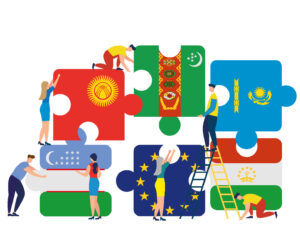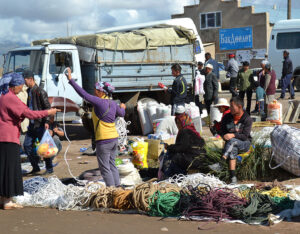Human Security in Central Asia: can the EU help out?

Download “Human Security in Central Asia: can the EU help out?”
EUCAM-Policy-Brief-21.pdf – Downloaded 373 times – 652.14 KBIntroduction
Among the many challenges facing the Central Asian states, security is one of the most pressing concerns. Yet the way these states discuss the issue is significantly affected by external actors’ approaches to security in the region. Russia and China are the two most influential countries in shaping the security strategies of the Central Asian governments, through bilateral relations and multilateral organisations such as the CSTO (Collective Security Treaty Organisation) and the SCO (Shanghai Cooperation Organisation). However, this does not mean that Kazakhstan, Kyrgyzstan, Tajikistan, Turkmenistan and Uzbekistan are “victims” of Russian and Chinese authoritarian pressure, without which they would take a more democratic approach. Even Russian influence, although much stronger in this area than China’s, cannot by itself explain the security decisions of the Central Asian regimes, as these decisions are chiefly driven by domestic issues and local political culture.
The European Union, along with Russia, China, and obviously the United States, is also an external security actor in the region. However, its visibility on the security issue is low; current EU mechanisms are too dispersed to be effective, it has no sufficiently defined goals, and has put forward no clear vision of how to address long-term security challenges. Consequently, there is no European “grand narrative” on Central Asian security. The EU’s tools seem poorly calibrated for dealing with security issues at a time when Central Asian governments and societies are anxious about ISAF’s withdrawal from Afghanistan, and are waiting for concrete propositions from international actors.
The aim of this policy brief is neither to criticise the lack of financial support that the EU allocates to Central Asia, nor the lack of leverage that is obtained through European programmes. Central Asia is not a priority in European external policies. It would be difficult for Europe to counter Russia’s and China’s influence and change the way that Central Asian regimes develop their short-term security strategies. But these limitations do not dispense with the need for the EU to provide a better definition of security, especially in light of its growing emphasis on human security, and to incorporate this into its current review of the EU Strategy for Central Asia. To this end, this brief will centre on the EU’s contribution to human security in Central Asia.
Regime security versus human security
Each Central Asian state faces its own set of security challenges. Tajikistan and Kyrgyzstan have to contend with a greater number of security issues, since both lack economic resources and face greater social challenges. Uzbekistan and Turkmenistan have more economic resources to offer their population, but their isolationist and authoritarian policies do not benefit their citizens. Uzbekistan also has a significant dilemma, in that its booming population can be either a geopolitical strength or a social weakness. Kazakhstan is without doubt the best endowed of the five states, but it too is not free of security challenges.
Security is multiform: it can mean military security to protect the independent states established in 1991 (preventing invasion by a neighbour); the political security of the established ruling elites (curbing pressures from external actors, limiting internal competition and holding on to power); the non-traditional security needed to protect these states from Islamist insurgency, civil wars and so-called low intensity conflicts, as well as the cultural security of the nation as an imagined ethnic group (averting demographic or cultural domination); energy security (ensuring economic development); and human security (avoiding state failure, water management and food security, threats to literacy and health care systems, and large migration flows).
Central Asian governments define the state not as the abstract entity of its aggregated citizens but as the embodiment of the current leadership and its strategies of legitimacy. Their real focus is to maintain regime security, whereas long-term state security can only be assured through human security. The concept of “human security”, promoted from 1994 by UN institutions – and which has provoked much debate about its pertinence – is larger. It includes environmental hazards, pandemics, food and energy security, pauperisation, migration, access to education, health care and transport, as well as corruption, child labour, human trafficking, the violation of basic freedoms and respect for human rights.
Central Asian regimes bear a certain amount of responsibility for the development of the human security threats with which they are now faced. Examples are multiple. In Turkmenistan for instance, Saparmurat Niyazov deliberately de-schooled the population in the hope that making people illiterate would facilitate the acceptance of a dictatorial regime.(1) This policy was furthered by severely limiting the opportunities for Turkmens to develop international contacts, contributing to the country’s isolation. In Uzbekistan, Islam Karimov’s regime has used the question of the Ferghana borders, and the supposed need to reinforce and securitise them, as a vehicle by which to frame political legitimacy, contributing to the delegitimisation of its Kyrgyz neighbour as the symbol of democratic chaos.(2) Tashkent’s isolationist policies exacerbate the already dire socio-economic situation of the border populations, increasing the tension between the Kyrgyz and the Uzbeks in Kyrgyzstan.(3)
Also child labour, which is part and parcel of the human security concept, is a threat to the well-being of the Uzbek population, while the forced labour in the cotton fields is organised by the Uzbek administration itself. In Tajikistan, Emomali Rakhmon’s obsession for big hydroelectric power stations has undermined international projects that focus on small, localised, community- based hydroelectric stations, as they do not enable the ruling elites to divert the international funds allocated to them as easily as do gigantic projects like Rogun. The official treatment of Islam is also creating insecurity, particularly in Uzbekistan and Tajikistan. The restrictions placed on religious practice, theological education and arbitrary imprisonment on the grounds of ‘Wahhabism’ pushes hundreds of people into worshipping in secret and a politicising of faith.(4)
Questions of smuggling, and especially of drug trafficking, reveal even more about these contradictory security agendas. Criminalised shadow economies prosper in Central Asia, since the administrative apparatus that is supposed to combat these practices is in fact a part of it, either because senior officials initiate them, or due to the corruption of law enforcement agencies. This is quite visible in Tajikistan and Kyrgyzstan, but also in the better regulated states such as Kazakhstan. There are strong indications that in all five Central Asian states, a number of state representatives at every administrative level, including high-ranking state officials, are directly involved in the drug trade. Western analysts generally agree that human trafficking, especially prostitution, to the Gulf countries is also facilitated by high-placed figures in Uzbekistan and Kyrgyzstan.
Last but not least, the lack of good governance and rule of law in Central Asia, resulting from the governments’ refusal to take these elements into account in the name of overriding regime security, fosters the delegitimisation of the state and its elites, especially law enforcement agencies. Corruption and private interests accentuate inefficiency in the implementation of state policies, with Kyrgyzstan and Tajikistan heading toward state failure. The impact of international aid is drastically reduced by the high levels of corruption. The conditions are set for the expression of political and social discontent, both in weak states like Tajikistan and Kyrgyzstan, as well as in authoritarian countries like Uzbekistan and Turkmenistan. Even in Kazakhstan, Nursultan Nazarbayev’s inability to solve the issue of his succession creates uncertainty and fuels rivalries within the elite, which combined with growing social tensions due to the meagre distribution of oil revenues outside the capital, has a negative impact on the country’s future.
The EU’s approach to Central Asia’s security challenges
The EU is aware of the growing security problems. The 2007 EU Strategy for Central Asia sets out a very consensual defini- tion of “common threats and challenges” which focuses on bor- der management, Afghanistan’s proximity and drug trafficking. The June 2010 Joint EU Council and Commission Implemen- tation Report of the EU Strategy for Central Asia recognises the deficiencies of the Strategy in terms of security, and calls for reinforced efforts in “security broadly speaking”.(5) It con- cludes: “It will be necessary to expand the concept of security to include major international and regional challenges such as human security, combating drug trafficking and trafficking in human beings, precursors, nuclear and radioactive materials, uranium tailings, border management, bio-safety, bio-security, combating terrorism and preventing radicalisation and extrem- ism, including via a continued emphasis on poverty alleviation. Combating corruption is an important element in countering many of these security challenges”.(6)
Meanwhile the European Parliament is developing its own po- sition on the implementation of the EU Strategy. The August 2011 draft report on this matter emphasises the terminology of human security, and “takes the view that the cornerstones of the EU’s new approach to the region must be human security and genuine regional cooperation”.(7) In this way it contributes to defining the EU’s security approach to the region as well as starting a broader debate on the EU’s role in security mat- ters beyond its neighbourhood. The EU and its member states can play a positive role in addressing security issues in Central Asia, especially when it comes to human security, through di- plomacy and development assistance.
However, the EU lacks clear goals in terms of “security broadly speaking”: how can the expression “broadly speaking” be trans- lated into concrete and effective programmes backed by limited financial capacity? Published documents do not give enough explanation about which elements of the security paradigm the EU intends to work on, and how it will reconcile the diverging focuses of the various European actors (Council, Commission, Parliament but also through the OSCE and NATO). The EU has also not discussed the way it intends to manage the contradic- tory interests of regime security and human security, nor how it aims to obtain meaningful benefits from the dialogue with Cen- tral Asian governments.
Basically, all the EU programmes and those managed by in- dividual member states are geared toward “security broadly speaking”. The main member states involved in Central Asia (the UK, Germany, France, Italy, Austria, the Netherlands and Finland) have bilateral or regional assistance programmes fo- cused on improving education, health care, food security, ac- cess to water, alleviating poverty, environmental concerns, and so on. At the EU level, the Rule of Law Initiative and Human Rights Dialogues are up and running while the BOMCA (Border Management in Central Asia) and CADAP (Central Asia Drug Action Programme) are funded by the EU but largely imple- mented by the UNDP. However, all these activities are not organised into a broad European vision for security support. They could achieve greater visibility and effectiveness by being bet- ter coordinated and presented as part of a larger plan.
Assessments of the effectiveness of these programmes are of- ten left unanswered due to a lack of independent audits. BOM- CA for instance focuses only on the main consensual definition of security, the border one, shared by both the EU and the Cen- tral Asian governments, but improving technical and logistical control at the border will have little impact if the issue of cor- ruption among border guards is not addressed. Some experts even suggest that these programmes for combatting corrup- tion, drug trafficking or illegal cross-border activities actually aid those Central Asian senior officials who are involved in traffick- ing. They supposedly help them eliminate their competitors by supplying them with logistics, methods and equipment, as well as by providing them with legitimacy. An effective fight against drug-trafficking requires real coordination between measures that target the producing (giving work to Afghan peasant farm- ers other than cultivating opium), transit (Central Asia) and consuming countries (Russia and Europe). Even where there is strong political will the difficulties involved in eliminating the administrative connections that drug traffickers have at their disposal remain considerable. The feeble commitment of the Central Asian governments, who are essentially acting under international pressure, cannot be considered a guarantee of success. Here again, it would be desirable for the European texts to overtly address these sensitive issues.
To protect the private interests of the ruling elites the Central Asian regimes tend to hide behind concepts of national secu- rity. This challenges the notion of comprehensive security, as this requires transparency in the way law enforcement agen- cies work; genuine accountability, or at least better oversight by the legislature and civil society of the decisions taken by state organs in the name of security; and an attempt to combat cor- ruption at the highest levels. The Central Asian governments’ refusal to address security sector reform (SSR), for instance, as proposed by the OSCE, reveals their lack of political will in regard to such questions.(8) Even Kazakhstan, otherwise the most forward-looking on these issues, has blocked fundamen- tal reforms of the security sector, despite being well aware of the fact that corruption erodes good governance and delegiti- mises the state in the eyes of its citizens.
The EU texts carefully avoid mentioning these difficulties, even though EU activities in the region are impeded by them. Instead the EU tends to congratulate itself on the institutionalisation of the exchanges and meetings, without taking into account the existing disparities with the Central Asian leadership over their conception of security or their lack of political will. The EU’s role in security matters, in terms of narrative and action, is therefore weakly calibrated and poorly assessed.
Why the human security concept can help the EU in addressing Central Asian challenges
First, “security broadly speaking” will continue to be in the minds of the international community as well as Central Asian governments. It can be presumed that with the expected, at least partial, ISAF withdrawal from Afghanistan and the still unknown evolution of the U.S. presence in the region over the next decade, the security environment will be drastically reshaped. The EU cannot be absent from this process. It has to coordinate and streamline its numerous financial and humanitarian commitments, as well as those of its member states, by advancing its own structured security narrative. This can constitute its ‘branding’ on the Central Asian scene vis-à-vis the other influential actors – Russia, China and the
U.S. The most appropriate narrative for an international actor with normative values that refuses hard security and instead positions itself in terms of soft power is indeed that of human security.
Second, human security is a way to engage in a dialogue with Central Asian governments that are often reluctant to discuss democracy or human rights. Instead, they focus on regime security and use threats to stability as an argument to protect the established elites, whereas the EU’s chief interests lie in concentrating on state security with a strong link to human security. The difference in interests is therefore considerable and should not be ignored. Nevertheless, the EU can make itself heard, including in the long term, by demonstrating to the Central Asian governments that weak governance and endemic corruption, i.e. human security issues, provide breeding grounds for their main concerns, such as terrorism, and drastically limit state effectiveness.
The EU can show through its programmes how human security is connected to state security. For instance, the EU Initiative on the Rule of Law is a good example of how to address security issues in a values-based approach, but it remains too limited in its ambition and financial backing. The EU needs to increasingly condition its assistance to good governance, human rights and security issues. Border management is also a positive step, but it is insufficient if not linked to good governance, anti-corruption, and drastic reforms of the security services and state organs. Support for security sector reform and governance should therefore be part, wherever possible, of the EU’s broader human security approach.
Third, human security should obviously be part of the moral objective of EU external policy, which seeks to defend the idea of a peaceful environment achieved through social and economic development rather than through hard, military security. More pragmatically, this approach offers the EU the only way to have a visible impact on security in this region given the strength of the other major security actors, especially Russia and China. This requires a better articulation of the connection between security and development. Social issues such as poverty, food and energy security, deteriorating access to health and education, alleviating the social impact of expected climate changes, and preparedness for natural catastrophes, are the real long-term issues for Central Asian societies. Meeting the practical day- to-day needs of the population should be one of the guiding principles of human security policy in Central Asia.
Conclusion
Over the last five years, the EU and European member states have attempted to contribute to many aspects of human security in Central Asia. However, their actions have lacked coordination, their conceptual tools have been poorly adapted, and above all they have been missing a grand narrative to explain why Europe does not limit its definition of security to counter-terrorism. Indeed, the EU views the well-being of citizens, social development and the rule of law as vital factors in long-term security. Now is the time to bring all these efforts together more clearly in a human security strategy, with a focus on development, the struggle against corruption and security sector reform, and governance.
The concept of human security can provide the EU with a conceptual framework that would highlight its geopolitical legitimacy in terms of the Russian, Chinese and American narratives on security. It would also increase its visibility to the Central Asian public. This security rethinking will not fundamentally change the region’s status quo. However, it will improve aid effectiveness; provide better cohesion between the different EU foreign policy goals; and most importantly, aid new Central Asian generations in thinking differently about their security challenges. It will therefore participate, even if only modestly, in the construction of a more stable future in Central Asia. In this sense the inclusion and practical use of the concept of human security in the current review of the EU Strategy would be welcome.
- Sébastien Peyrouse, Turkmenistan. Strategies of Power, Dilemmas of Development
(Armonk: M. E. Sharpe, November 2011). - Nick Megoran, “The critical geopolitics of the Uzbekistan–Kyrgyzstan Ferghana Valley boundary dispute, 1999–2000”, Political Geography, vol. 23, 2004, pp. 731–764.
- Neil Melvin, “Promoting a Stable and Multiethnic Kyrgyzstan: Overcoming the Causes and Legacies of Violence,” Central Eurasia Project Occasional Paper Series No. 3, March 2011.
- Sébastien Peyrouse, “Islam in Central Asia: National Specificities and Post-Soviet Globalization”, Religion, State and Society, vol. 35, no. 3, 2007, pp. 245-260.
- The Joint EU Council and Commission Implementation Report of the EU Strategy for Central Asia, 28 June 2010, p. 6.
- Ibid, p. 26.
- Nicole Kiil-Nielsen, Draft report on the state of implementation of the EU Strategy for Central Asia, August 2011, p. 10, http://www.europarl.europa.eu/sides/getDoc. do?pubRef=-//EP//NONSGML+COMPARL+PE-469.951+02+DOC+PDF+V0// EN&language=EN.
- M. Hartog (ed.), Security Sector Reform in Central Asia: Exploring Needs and Possibilities, Greenwood Papers (Groningen: CESS, 2010).







